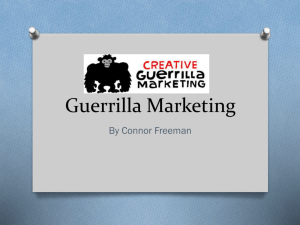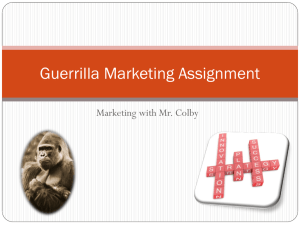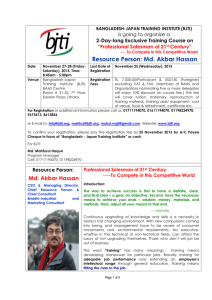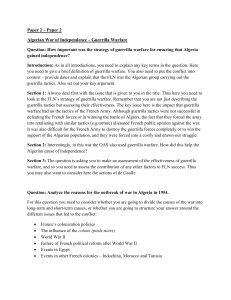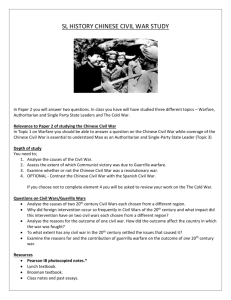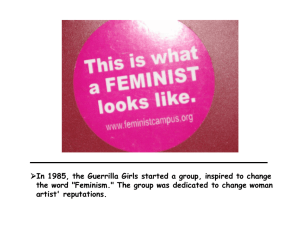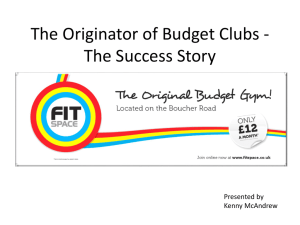How Small Businesses Are Using Guerrilla Marketing
advertisement
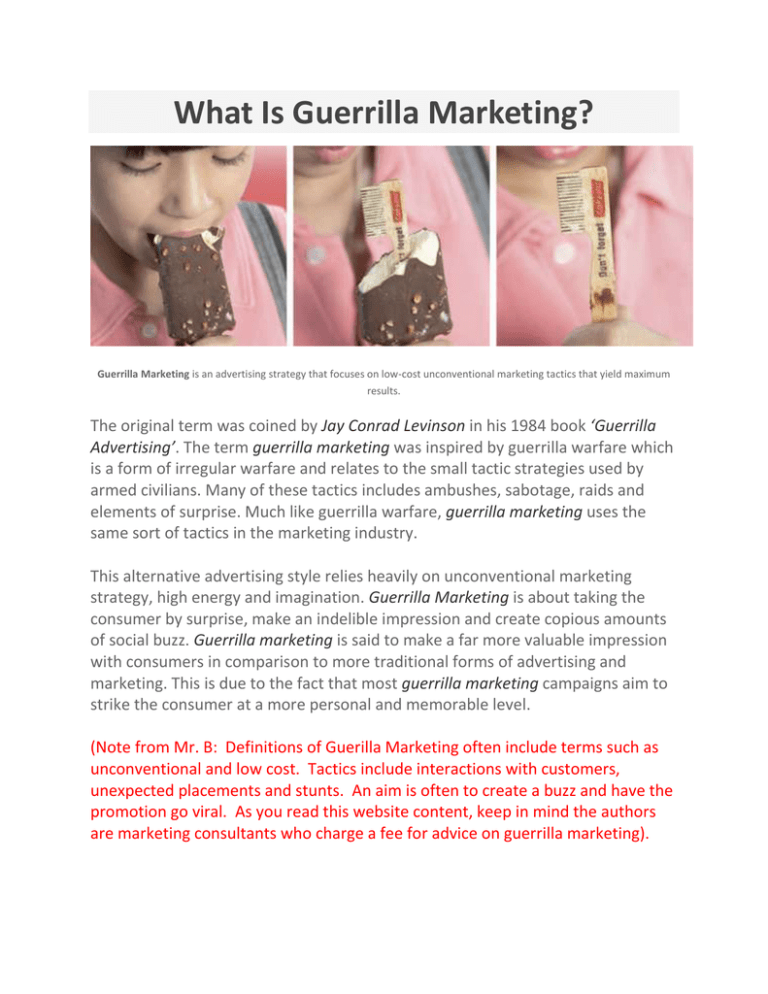
What Is Guerrilla Marketing? Guerrilla Marketing is an advertising strategy that focuses on low-cost unconventional marketing tactics that yield maximum results. The original term was coined by Jay Conrad Levinson in his 1984 book ‘Guerrilla Advertising’. The term guerrilla marketing was inspired by guerrilla warfare which is a form of irregular warfare and relates to the small tactic strategies used by armed civilians. Many of these tactics includes ambushes, sabotage, raids and elements of surprise. Much like guerrilla warfare, guerrilla marketing uses the same sort of tactics in the marketing industry. This alternative advertising style relies heavily on unconventional marketing strategy, high energy and imagination. Guerrilla Marketing is about taking the consumer by surprise, make an indelible impression and create copious amounts of social buzz. Guerrilla marketing is said to make a far more valuable impression with consumers in comparison to more traditional forms of advertising and marketing. This is due to the fact that most guerrilla marketing campaigns aim to strike the consumer at a more personal and memorable level. (Note from Mr. B: Definitions of Guerilla Marketing often include terms such as unconventional and low cost. Tactics include interactions with customers, unexpected placements and stunts. An aim is often to create a buzz and have the promotion go viral. As you read this website content, keep in mind the authors are marketing consultants who charge a fee for advice on guerrilla marketing). Guerrilla marketing is often ideal for small businesses that need to reach a large audience without breaking the bank. It also is used by big companies in grassroots campaigns to compliment on-going mass media campaigns. Individuals have also adopted this marketing style as a way to find a job or more work. The History of Guerrilla Marketing Advertising can be dated back to 4000 BC where the early Egyptians used papyrus to make sales messages and wall posters. What we consider traditional advertising and marketing slowly developed over the centuries but never really boomed until the early 1900s. It was at this time that the main goal of advertisements was to educate the consumer on the product or service rather than to entertain and engage them. In 1960, campaigns focuses on heavy advertising spending in different mass media channels such as radio and print. It wasn’t till the late 1980s and early 1990s that cable television started seeing advertising messages. The most memorable pioneer during this time was MTV where they focused on getting the consumer to tune in for the advertising message rather than it being the by-product of a featured show. Agencies struggled to make an impression on consumers and consumers were tired of being marketed to. It was time for a change. In 1984, marketer Jay Conrad Levinson introduced the formal term in his book called, “Guerrilla Marketing.” Levinson comes from a background as the Senior Vice-President at J. Walter Thompson and Creative Director and Board Member at Leo Burnett Advertising. In Levinson’s book, he proposes unique ways of approaching and combating traditional forms of advertising. The goal of guerrilla marketing was to use unconventional tactics to advertise on a small budget. During this time, radio, television and print were on the rise, but consumers were growing tired. Levinson suggests that campaigns need to be shocking, unique, outrageous and clever. It needs to create buzz. Small businesses started changing their ways of thinking and approached marketing in a brand new way. The concept of guerrilla marketing continues to develop and grow organically. You can find more information about Jay Conrad Levinson at the Official Site of Guerrilla Marketing. How Big Businesses Are Using Guerrilla Marketing Guerrilla marketing originally was a concept aimed towards small businesses with a small budget, but this didn’t stop big businesses from adopting the same ideology. Larger companies have been using unconventional marketing to compliment their advertising campaigns. Some marketers argue that when big businesses utilize guerrilla marketing tactics, it isn’t true guerrilla. Bigger companies have much larger budgets and their brands are usually already well established. It can also be far more risky for a big business to do guerrilla marketing tactics. In some instances, their guerrilla stunts can flop and ultimately become a PR nightmare. Smaller businesses don’t run as much risk as most people will just write it off as another failed stunt. One such example would be the famous 2007 Boston Bomb Scare caused by Turner Broadcasting on January 31, 2007. What started off as a guerrilla marketing campaign to promote a new film featuring a Cartoon Network show called Aqua Teen Hunger Force, turned into a citywide bomb scare. Turner Broadcasting with the help of guerrilla marketing agency, Interference, Inc., placed battery-powered LED placards resembling the ‘Mooninite’ character on the cartoon show. The LED placards were placed throughout Boston, Massachusetts and the surrounding cities. The placards were placed in random locations and remained unlit during the day. At night the placards lit up to show the ‘Mooninite’ character putting up his middle finger. The devices resembled some characteristics of explosive devices and soon caused the scare. The campaign ended up costing Turner Broadcasting and Interference, Inc. $2 million for the incident. The campaign itself received a lot of criticism both good and bad. “Nobody could have conceived that Lite-Brite cartoon character was going to evoke a bomb scare. Once you take the emotion out of it, it was a really innovative campaign. That’s what people will remember. Many of the brands we work with are asking us for guerrilla marketing campaigns, with an element of mystery, but they don’t really understand what it means. Ewen could elevate this experience into something for the industry to learn from, counseling on what it means. He should be out there speaking about this to industry groups.” - Donna Sokolsky, CoFounder of Spark PR in San Francisco Well it seems that many companies have learned from past successes and failures. One major brand that has been doing a wonderful job is Coca-Cola. In January 2010, The Coca-Cola Company created the “Happiness Machine” video with the help of interactive marketing agency, Definition 6. The video featured a Coca-Cola vending machine that dispensed a lot more than just a cold beverage. The film was shop at St. John’s University in Queens, New York, using 5 strategically placed hidden cameras. The reactions from the students were completely unscripted. The video went viral and now has over 4.5 million views on YouTube. In May 2010, it won a prestigious CLIO Gold Interactive Award. The film had the highest penetration in Brazil, Mexico, Japan and Russia. After seeing the amazing ROI on this video, Coca-Cola decided to continue the ‘Happiness’ theme by releasing several other videos using the same concept. On October 14th, 2012, Red Bull and Austrian extreme athlete Felix Baumgartner set a world record for the highest skydiving jump. The Red Bull Stratos was a campaign to send Baumgartner on a death defying jump at over 128,100 feet into the stratosphere. Baumgartner broke the speed of sound reaching an estimated speed of 833.9 mph (1,342.8 km/h) after jumping out of a helium-filled balloon. The entire trip back to earth lasted 9:09 minutes with 4:22 of that time in freefall. More importantly, Red Bull attracted much deserved attention for this grand stunt. On this day, they also broke social media records when they reached over 8 million confirmed concurrent views on YouTube. The team achieved this with several grand efforts on their social media team. By visiting the Red Bull Stratos website, users could tune in to the jump LIVE, stay engaged via the twitter stream and a connect with others on Facebook. Related Posts on Creative Guerrilla Marketing: Follow Coca-Cola's Amazing Unconventional Marketing Efforts! Coca-Cola's New Happiness Truck Campaign Coca-Cola Comes Back With The Happiness Machine for Couples 3 Viral Marketing Lessons Learned From The Red Bull Stratos Jump Sources: Coca-Cola, Red Bull Stratos How Small Businesses Are Using Guerrilla Marketing Guerrilla marketing may be the right solution for your small business. Why? When executed well, it will often be low cost yet reach a highly targeted audience. It can also be a great way to get noticed, distinguish from the competition and earn a reputation for being fun and different. In an interview with Entrepreneur magazine, several guerrilla marketing agency experts divulged that good guerrilla marketing is… “…unauthorized and disruptive” and “sticky.” - Brett Zaccardi of Street Attack “…brand activation that isn’t 100 percent permitted by the city, event or establishment.” - Adam Salacuse, Founder and President of ALT TERRAIN “…is a state of mind. It simply isn’t guerrilla if it isn’t newsworthy.” - Drew Neisser, CEO of Renegade Marketing One of the most famous examples is The Blair Witch Project, a film that was promoted using guerrilla marketing efforts. The Blair Witch Project is a 1999 American psychological horror film that was produced by five graduates of the University of Central Florida Film Program with a minimal budget and a camera. The two set up an internet campaign to spread rumors about a fictitious legend of “the Blair Witch.” The duo created a website devoted to the Blair Witch to help support the case for this fictitious woods-based spectre. They ran with the tagline, “In October of 1994, three student filmmakers disappeared in the woods near Burkittsville, Maryland, while shooting a documentary. A year later, their footage was found.” In April 1998, the preview aired on Bravo and it drew a lot of attention. The producer of the Bravo show Split/Screen asked the duo to build a stand-alone website, because Blair Witch comments were dominating its own site and discussion board. There were people interested in this and the film wasn’t even done. “That’s how the whole thing started. The website launched in the summer of 1998 and in November, we found out we were accepted into Sundance Film Festival. We had all this buzz going into Sundance. It was not because we spent money. It was because we had fans already, who hadn’t even seen the film. It was eye-opening,” says Mike Monello, a co-creator of The Blair Witch Project. The Blair Witch Project grossed $248,639,099 worldwide. Related Posts on Creative Guerrilla Marketing: 6 Great Guerrilla Marketing Campaigns Sources: Entrepreneur http://www.creativeguerrillamarketing.com/what-is-guerrilla-marketing/

